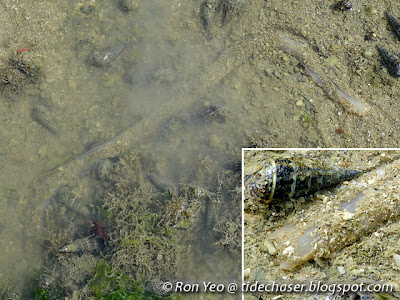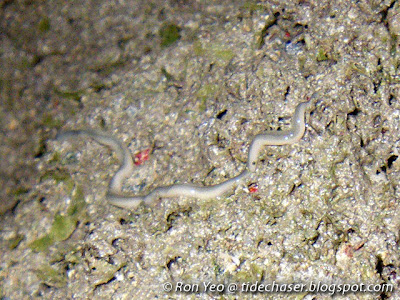Ribbon Worms (phylum Nemertea) are soft-bodied, bilaterally symmetrical animals that are mostly long, thin and flat (like a ribbon). Some species, however, have short and wide bodies. They have an eversible proboscis (with either a sticky tip or tipped with a venomous stylet) which can shoot out just above the mouth to capture/retrieve their food. Carnivorous species are usually venomous, and use their venom to knock out or even kill their prey, which could be animals smaller or even as big as themselves. Others may be filter feeders, feeding on plankton. Ribbon worms respire through their skins. A number of species are known to be poisonous and some can even secrete toxins to deter predators.
Most species (except the freshwater species) have separate sexes, and can reproduce sexually. Fertilisation is done externally - some broadcast their eggs and sperms into surrounding waters, while others may lay the eggs in burrows or cocoons. Bigger species can usually reproduce asexually by breaking up and regenerating the lost parts, thus growing into new individuals from each broken fragments.
So far I still did not have the luck to see freshwater ribbon worms in Singapore, and hence will only highlight the marine ribbon worms and some of those which we thought are terrestrial ribbon worms.
Marine Ribbon Worms

The Five-lined Ribbon Worm (Baseodiscus quinquelineatus) is commonly seen in the region, usually with 5 distinctive black lines running along the back of the worm. It can sometimes be confused with another similar-looking species, Baseodiscus delineatus, which have numerous lines as well, but the lines are usually incomplete and broken in between, and there are usually several dark blotches on its back. Both worms can grow to about 1m long.

This red ribbon worm is likely to be a Gorgonorhynchus sp.

This long pinkish unknown ribbon worm is sometimes encountered on our sandy shores.

This long and slimy ribbon worm is occasionally seen with sand and other small particles stuck to the layer of mucus on its body. It lives in a burrow, which it retracts into when disturbed.

This small ribbon worm is usually not more than a few mm wide. It is usually found on rocky areas at the high tide zone. A greyish or greenish line runs down its back.

The above is a Mangrove Ribbon Worm (Pantinonemertes sp.), which is usually seen on mud lobster mound or under fallen logs. Like many ribbon worms, it has a long eversible proboscis which it uses to snare prey.
Terrestrial Ribbon Worms
Ivan, in his blog, had suggested that these tiny worm-like animals (1-2mm wide, about 5cm long) which we have seen on low shrubs or moist ground are likely to be ribbon worms.

This yellowish species with stripes can be found both on the ground and on the leaves of low shrubs. It has a pair of small eyes.

The above terrestrial ribbon worm is seen constricting a small insect.

This brownish one was found on moist ground. It is the about the same size as the previous one.

It has a pair of eyes too. The eyes are believed to be very simple - able to detect light and darkness but probably cannot form clear images.
References
Most species (except the freshwater species) have separate sexes, and can reproduce sexually. Fertilisation is done externally - some broadcast their eggs and sperms into surrounding waters, while others may lay the eggs in burrows or cocoons. Bigger species can usually reproduce asexually by breaking up and regenerating the lost parts, thus growing into new individuals from each broken fragments.
So far I still did not have the luck to see freshwater ribbon worms in Singapore, and hence will only highlight the marine ribbon worms and some of those which we thought are terrestrial ribbon worms.
Marine Ribbon Worms

The Five-lined Ribbon Worm (Baseodiscus quinquelineatus) is commonly seen in the region, usually with 5 distinctive black lines running along the back of the worm. It can sometimes be confused with another similar-looking species, Baseodiscus delineatus, which have numerous lines as well, but the lines are usually incomplete and broken in between, and there are usually several dark blotches on its back. Both worms can grow to about 1m long.

This red ribbon worm is likely to be a Gorgonorhynchus sp.

This long pinkish unknown ribbon worm is sometimes encountered on our sandy shores.

This long and slimy ribbon worm is occasionally seen with sand and other small particles stuck to the layer of mucus on its body. It lives in a burrow, which it retracts into when disturbed.

This small ribbon worm is usually not more than a few mm wide. It is usually found on rocky areas at the high tide zone. A greyish or greenish line runs down its back.

The above is a Mangrove Ribbon Worm (Pantinonemertes sp.), which is usually seen on mud lobster mound or under fallen logs. Like many ribbon worms, it has a long eversible proboscis which it uses to snare prey.
Terrestrial Ribbon Worms
Ivan, in his blog, had suggested that these tiny worm-like animals (1-2mm wide, about 5cm long) which we have seen on low shrubs or moist ground are likely to be ribbon worms.

This yellowish species with stripes can be found both on the ground and on the leaves of low shrubs. It has a pair of small eyes.

The above terrestrial ribbon worm is seen constricting a small insect.

This brownish one was found on moist ground. It is the about the same size as the previous one.

It has a pair of eyes too. The eyes are believed to be very simple - able to detect light and darkness but probably cannot form clear images.
References
- Kuiter, R.H. and H. Debelius. 2009. World Atlas of Marine Fauna. IKAN-Unterwasserachiv. 723 pp.
- Ruppert, E.E. and R.D. Barnes. 1991. Invertebrate Zoology (International Edition). Saunders College Publishing. U.S.A. 1056 pp.
- Allen, G.R. and R. Steene. 2002. Indo-Pacific Coral Reef Field Guide. Tropical Reef Research. 378 pp.


No comments:
Post a Comment